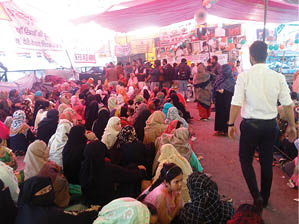For over two months, life has turned into a nightmare for millions of commuters across the national capital of India. While the BJP sought to pin the responsibility for the gridlock caused by the Shaheen Bagh protests on the Aam Aadmi Party, it was pointed out by Chief Minister Arvind Kejriwal and Deputy Chief Minister Manish Sisodia that police forces in Delhi operated under the control of the Ministry of Home Affairs and not the Delhi government. This being the case, it was added that the primary responsibility for clearing the blockade vested with the MHA, a conclusion that the majority of voters in the national capital apparently agreed with. The hands-off manner in which that ministry has dealt with developments in Shaheen Bagh are reminiscent of magnanimity that harks back to the always “turn the other cheek” stance of Mahatma Gandhi towards the numerous efforts by the British to crush into insignificance the freedom movement. Clearly, the MHA believes that the patience of the protesters who have converted a major arterial road in Delhi into their private residence will finally ebb so that they go back to their actual homes and thereby allow traffic to flow freely once more. As it has done in the case of several other matters, the Narendra Modi government has left the question of ending the Shaheen Bagh blockade to the Supreme Court, which has appointed three interlocutors to discuss with the protesters a way out of the impasse. An impasse that has for much too long a period stopped traffic from passing, thereby affecting the livelihood of close to a million people directly. Not surprisingly, the apparent immunity from official action enjoyed by the protesters at Shaheen Bagh are leading to similar “chakka jam” protests in other metropolitan centres, which have each the potential of severely disrupting traffic and therefore the economy of the cities affected. It is clear that a Home Minister of the competence and energy of Amit Shah must be having a strategy to deal with the Shaheen Bagh protests so that traffic once again flows freely, and before copycat protests erupt across the rest of the country. What these measures will be have not yet been communicated to the public. Across India, citizens are watching what is taking place at Shaheen Bagh with incredulity and increasingly, a sense of resignation. Few believe that the Supreme Court interlocutors will be able to resolve the issue, given that from the start, protesters have demanded the rollback of the Citizenship Amendment Act (CAA) and the scrapping of any plans for a National Register of Citizens of the kind that is seen in countries across the globe, including in the rest of the subcontinent. Those congregated at Shaheen Bagh may have the right to protest, but they should continue their protests in a manner which prevents a blockade of arterial roads and thereby affects and in many cases snuffs out livelihoods.
As has been mentioned often by leading jurists, the right to protest is fundamental in a democracy. But does that freedom include the right to disrupt the lives of hundreds of thousands of citizens and make their commutes hellish? Does that include the right to commit deeds that affect adversely the livelihood of hundreds of thousands of hard-working citizens? Would not such an unbridled right lead to chaos and anarchy? There have been a few efforts at making those responsible for loss of property as a consequence of public protests reimburse such losses. What about protests that extinguish the livelihoods of citizens? The jury may be out on CAA, and several may disapprove of the law despite the fact that even 10-year olds in some parts of the country are facing the wrath of the law for daring to speak with disfavour about the CAA. Modifying the CAA by getting passed laws opening the door to dual citizenship for such persons (as well as others) may be a way out of the stalemate witnessed between proponents and opponents of the CAA. Getting passed an ordinance that enshrines the power to seek financial recompense from those whose actions cause business and other loss to others may be a measure whose time has arrived. Surely the investigative agencies of the MHA must by now be aware of the identities of those who are encouraging protesters to continue blocking roads. Such individuals need to bear at least some of the financial cost of the moves they are making. If the Delhi police remains unable to work out a scheme to ensure smooth flow of traffic more than two months after the blockade became effective, it is a sad commentary on a force tasked with responsibility for ensuring the safety and security of the citizen as she or he goes about in pursuit of education, leisure or livelihood. Should the authorities fail in the task of restoration of normalcy, the Supreme Court may need to step in and pass orders mandating removal of the blockade that is being endured by nearly a million residents of Delhi. Blocks in an artery sometimes lead to a heart attack. Before the Shaheen Bagh protests spread to other areas and lead to a calamity such as a complete breakdown of order, this newspaper hopes that a government led by an administrator of the calibre of Prime Minister Narendra Modi will find ways of ensuring that the Shaheen Bagh protests either end or continue in a manner that no longer causes vehicular gridlock and suffering. Enough is enough.

